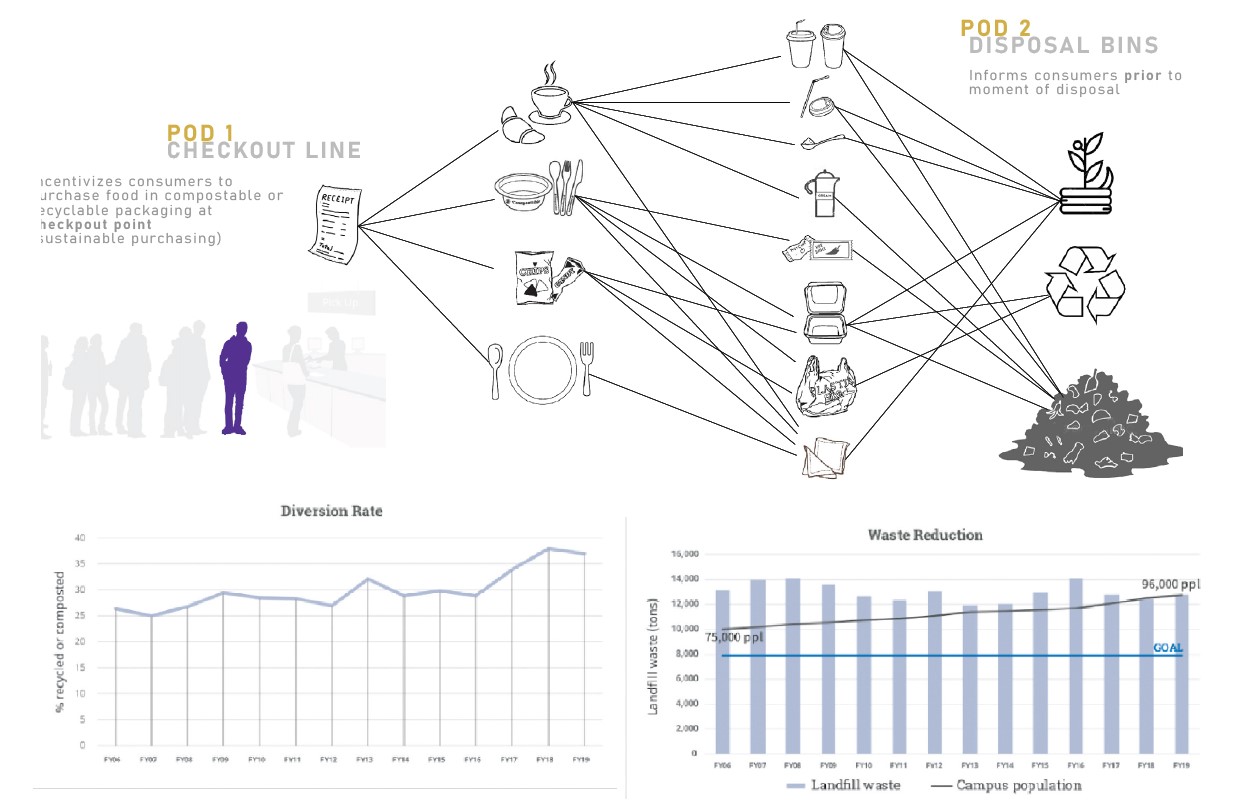︎ Move In, Less Out
Mobile application to affect Point of Decision in managing food and health
By Jamie Wiberg ︎


Hypothesis
According to the U.S. EPA, food waste is the single largest component of waste sent to disposal, constituting 22% of discarded municipal solid waste. In 2017, 41 million tons of food waste were generated, with only 6.3% diverted from landfills and incinerators for composting.1 Implementing a food and health management app for students, faculty, and staff on the U-M Campus will improve food literacy and environmental impact from food waste in the short-term, and improve diet and health in the long-term.
According to the U.S. EPA, food waste is the single largest component of waste sent to disposal, constituting 22% of discarded municipal solid waste. In 2017, 41 million tons of food waste were generated, with only 6.3% diverted from landfills and incinerators for composting.1 Implementing a food and health management app for students, faculty, and staff on the U-M Campus will improve food literacy and environmental impact from food waste in the short-term, and improve diet and health in the long-term.
- How?
1. Reduce waste and improve diet decisions.
2. Provide health and waste management model as leading institution.
3. Educate / inspire students, faculty, and staff to become involved in helping solve the envrionmental sustainability issues facing the world, improving our health and well-being.
4. Stimulate market demand for healthier, greener products
- What?
An app designed through point of decision design (POD) that has a QR code associated to every food packaging item. The app features
include: fast facts of food/packaging, compost, recycle, or trash information, the Waste Race, possible ways to reuse packaging and a collaborative inventory base.
- So What?
Front-end dietary health risks associated with packaging includes poor food quality resulting in high blood pressure or chronic diseases, as well as toxic substances associated with the physical packaging.2 Back-end health risks include respiratory and water-borne illness caused by the degradation of landfill wastes which produce toxic leachate and greenhouse gases.3 Food waste and food packaging account for 30-40% of what U-M sends to landfill from most buildings.4 The University has a goal to reduce waste sent to landfills by 40% by 2025. We have currently reached 3% of this goal.4

Uninformed disposal leads to contamination in waste facilities, causing properly recycled items to go to the landfill instead.
Design to Outcomes
Implementing a food and health management app for students, faculty, and staff on the U-M Campus will improve food literacy and environmental impact from food waste in the short-term, and improve diet and health in the long-term. Methods of analysis include retrieving the amount of waste in landfill, recycling, and composting bins (before and after intervention). A survey of student food waste knowledge (before and after intervention), will also be utilized.
︎
Works Cited
1. Onufrak, S. J., Watson, K. B., Kimmons, J., Pan, L., Khan, L. K., Lee-Kwan, S. H., & Park, S. (2018). Worksite Food and Physical Activity Environments and Wellness Supports Reported by Employed Adults in the United States. American journal of health promotion : AJHP, 32(1), 96–105. https://doi.org/10.1177/0890117116664709
2. Quintiliani, Lisa, Sattelmair, Jacob, and Sorensen, Glorian. (2007). The workplace as a setting for interventions to improve diet and promote physical activity. World Health Organization. https://www.who.int/dietphysicalactivity/Quintiliani-workplace-as-setting.pdf?ua=1
3. Johns Hopkins Bloomberg School of Public Health. Institute for Health and Productivity Studies. ; Centers for Disease Control and Prevention (U.S.) (2016) .Physical Activity in the Workplace: A Guide for Employers. The Institute for Health and Productivity Studies, Johns Hopkins Bloomberg School of Public Health. https://www.jhsph.edu/research/centers-and-institutes/institute-for-health-and-productivity-studies/_docs/archived-projects/WHRN_PA.pdf
4. Siegel, RP (2013). How Biking Improves Employee Productivity. Tripli Pundit the business of doing better. https://www.triplepundit.com/story/2013/how-biking-improves-employee-productivity/59136